Unlabeled Seeds Arriving in Mailboxes
The Minnesota Department of Agriculture (MDA) continues to receive reports of citizens getting unsolicited seed packages in the mail. To date, over 800 Minnesotans have made reports to the department.
The packages have contained a variety of seeds. Seed analysts with the MDA Lab Services Division have identified some as cosmos, radish, mung bean, juniper, basil, cucurbit, and zinnia. While these are not seeds from invasive plants, seeds may carry disease and pests can hide in packaging. So far, there is no indication these unsolicited seeds have gone through appropriate inspection or that they are properly labeled.
The MDA is working with the United States Department of Agriculture (USDA) on the issue. All seeds collected in Minnesota are being sent to USDA for additional identification and destruction. Federal officials are investigating the source of the seeds, and the USDA is currently referring to the situation as a “brushing scam” where people receive unsolicited items from a seller who then posts false customer reviews to boost sales. Their latest statement on the seed packages can be found here.
Contact the MDA through this form if you have received unsolicited seeds for mailing and disposal instructions.
Read More
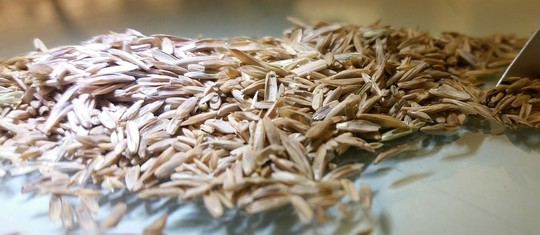
Swede Midge - A Growing Threat to Your Garden
Swede midge (Contarinia nasturtii) is a small fly and invasive insect native to Europe and southwest Asia that negatively impacts vegetable crops in the family Brassicaceae. Primary hosts include broccoli, cabbage, canola, cauliflower, collards, Brussels sprouts, kale, rutabagas, and radish. It was first identified in North America in Ontario, Canada in 2000, then subsequently detected in the United States in 2004 in upstate New York. Since that time, it has spread to at least nine states and six Canadian provinces, with discoveries in Minnesota (2016) and Wisconsin (2019) being the most recent.
In Minnesota, swede midge has the potential to severely impact small community gardens, community supported agriculture, immigrant farming communities, and the canola industry. Minnesota is currently 4th in the nation in canola production with an annual value of over $7 million (USDA NASS). The main pathways of spread for this insect is the movement of infested soil and transplant material.
In 2020, the Minnesota Department of Agriculture (MDA) has observed swede midge causing damage at community gardens in Minneapolis and St. Paul. Plant damage caused by swede midge is the result of larval feeding at the growing points of the plant. The larvae secrete toxins while feeding that can result in swollen tissue and abnormal growth. Common signs of swede midge damage include puckered and crinkled leaves, distorted growing points, blind heads, brown scarring, and multiple small head formations.
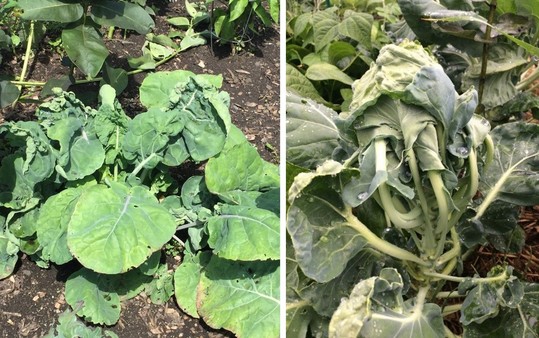 Left: Leaf puckering on cauliflower. St. Paul, MN, 2017.
Right: Leaf puckering, distorted and twisted growth on Brussels sprouts. St. Paul, MN 2018.
There are relatively few options for managing swede midge. The most effective approaches include cultural controls and implementing effective sanitation measures. Swede midge populations build up in the soil; therefore, rotating crop types is extremely important. To learn more about swede midge biology and management, visit the following online resources:
If you think you have seen or have a swede midge infestation, please report a description of the location and the damage seen to Arrest the Pest or 1-888-545-6684 (Voicemail).
Read More
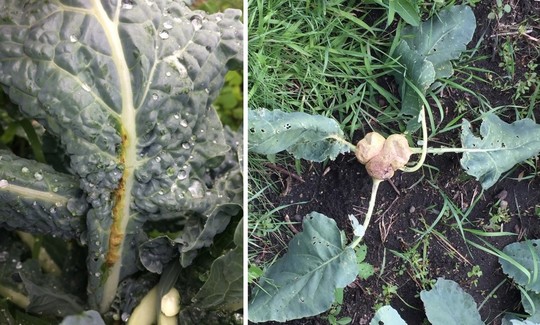 Left: Brown scarring on stem of kale. St. Paul, MN 2018.
Right: Multiple head formation on kohlrabi. St. Paul, MN 2017.
European Chafer
The European chafer beetle (Amphimallon majale), an insect that can cause major damage to turf grass, has been found for the first time in Minnesota.
A resident of south Minneapolis first noticed large swarms of beetles in their yard at dusk and reported the find to a University of Minnesota Extension entomologist who suspected the beetles were European chafers and reported them to the Minnesota Department of Agriculture (MDA). The MDA worked with the United States Department of Agriculture to confirm the identity of the insect since it had never been found in Minnesota before.
The adult insects are about a half-inch long and tannish in color. They are similar to the “June bugs” commonly found in Minnesota in early summer but are generally a bit smaller and lighter in color. The beetles emerge from the soil between mid-June and early July and are active on warm evenings for several hours just before and after sunset. The white grubs can range from ¼-inch to 1-inch long with a dark brown head and noticeable legs.
You can report suspected European chafer to the MDA’s Arrest the Pest line at arrest.the.pest@state.mn.us or 1-888-545-6684. Before making a report, please capture the insect, take a picture, and put the insect in a container or plastic bag and place it in the freezer. The MDA will contact you if the specimen is needed for confirmation.
Read More
Full Press Release
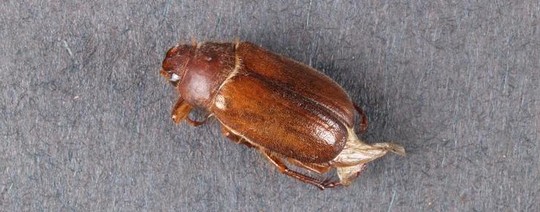 Adult European Chafer beetle. Bruce Watt, University of Maine, bugwood.org 5507089.
Insects Commonly Confused as Invasive Species
This month there have been many reports of common insects being mistaken as invasive insects.
|
Fall Webworm (Hyphantria cunea)
This insect makes webs/tents at the end of branches. The silken tents can be filled with leaf litter and caterpillars. Fall webworm caterpillars are commonly mistaken as gypsy moth caterpillars.
Read More
|
|
 |
|
Japanese Beetle (Popillia japonica)
This insect is about 1/3 to 1/2 inch long, with a metallic green head and thorax, and copper-brown wing covers. This insect is invasive but is also mistaken as European chafer beetle or emerald ash borer.
Read More
|
|
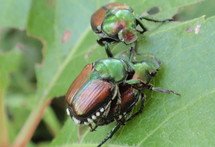 |
|
Cicada Killer Wasp (Sphecius speciosus)
This insect is about 1.5 inches long, with amber-colored wings, reddish brown legs, and a black abdomen with yellow bands. Cicada killer wasps are commonly confused as "murder hornets."
Read More
|
|
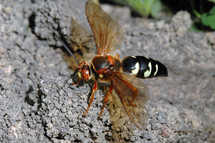 |
Weed of the Month
August: An Update on Palmer Amaranth After Years of Treatment in Minnesota
Palmer amaranth (Amaranthus palmeri) was first found in Minnesota in 2016. Since then, small infestations have been documented along with identified pathways.
Palmer amaranth was originally brought into the state via a contaminated conservation seed mix and was planted in 34 plantings across Lyon and Yellow Medicine counties. Those plantings were surveyed and plants were identified. Walking through each individual planting helped the Minnesota Department of Agriculture (MDA) understand the plantings and helped determine the best action needed.
Read More
July: Recreation and Invasive Plants - What You Can Do
Summer is a great time to get outside and enjoy the nature we have in Minnesota, and many of us have hobbies that get us into the woods or onto the trails.
Think back to the last time you went hiking, horseback riding, biking, camping, ATV riding, or whatever it is you like to do outside – did you remember to clean your equipment, clothes, or pets before heading home or off to your next adventure? It may not be on your radar yet, but invasive plants can be spread accidentally as we recreate.
Read More
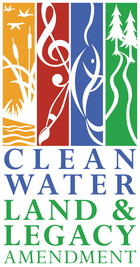
Conservation Partners Legacy (CPL) Grant Program
The Minnesota Department of Natural Resources (DNR) manages the CPL program to provide competitive matching grants from $5,000 up to $400,000 to local, regional, state, and national nonprofit organizations and government entities. Grants must restore, protect or enhance prairies, wetlands, forests, or habitat for fish, game, or wildlife in Minnesota. A 10% match of non-state funds is required for all grants. The match may be cash or in-kind resources. The amount and source of match must be identified at the time of application. Total project costs may not exceed $575,000. CPL is a reimbursement-based grant program.
Application deadline:
- September 14 for Expedited Conservation Project (ECP) grant cycle
- September 21 for Traditional and Metro grant cycles
Read More
|
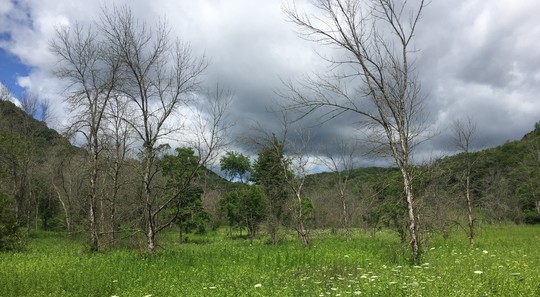 Landscape Scale Restoration Grants
The purpose of the Landscape Scale Restoration (LSR) competitive grant program is to encourage collaborative, science-based restoration of priority forest landscapes, leverage public and private resources, and support priorities identified in State Forest Action Plans. The LSR request for applications comes out once per year.
Examples of Eligible Projects:
- Community tree planting projects in communities with a population of less than 50,000.
- Strategic outreach efforts to land managers/owners facing threats from urban sprawl, invasive species, and wildfire, and complementary efforts to improve rural prosperity, as long as the project includes on-the ground outcomes as well.
- Survey, prioritization, and treatment to control invasive plants in a high-priority landscape.
- Prevention and preparedness projects in advance of known invasive pests, with on-the-ground outcomes.
- Restoration of forests following damaging events to promote desired future conditions.
Application deadline: September 17
Read More
 Coronavirus Recommendations
The MDA has prepared many recommendations for citizens, staff, and employers in relation to growing and selling plants safely.
To find a local farmers market, U-pick farm, or other Minnesota grown products, please visit the Minnesota Grown directory. For more information on COVID-19 in Minnesota please visit mn.gov/covid19.
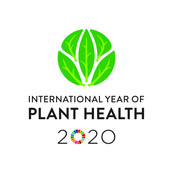
2020 Year of Plant Health
The United Nations declared 2020 as the International Year of Plant Health (IYPH). The year is a once in a lifetime opportunity to raise global awareness on how protecting plant health can help end hunger, reduce poverty, protect the environment, and boost economic development.
Read More
|

Minnesota Certified Firewood
The Minnesota Department of Agriculture has certified nine firewood producers in the state of Minnesota for heat treatment of firewood. Look for the logo when purchasing firewood. It means the firewood is safe to move and is free of emerald ash borer.
Certified firewood producers:
- Emily Forest Products
- JN Firewood
- Leroy Habiger "The Firewood Man"
- Minnesota Firewood LLC
- Paul's Fireplace Wood Inc
- Price Firewood
- Sunset Firewood Company
- TSL Firewood
- Wood Chuckers Firewood LLC
|
|